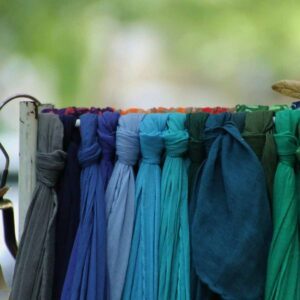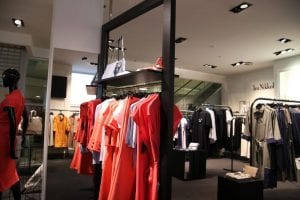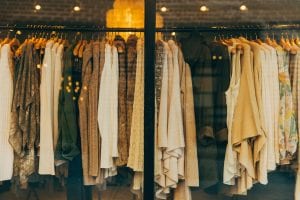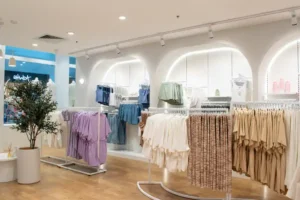As customers become increasingly promiscuous and disloyal when it comes to where they shop, retailers need to think of new and innovative ways to recapture lost consumers. Even in the digital age, the bricks-and-mortar store remains one of the best ways for retailers to attract customers and stand out from their competition.
We already know that design-driven brands are outperforming their completion by over 200% but are retailers really aware of the power of great retail design?
Are brands really maximising considered, creative interiors to drive store footfall, or are they simply relying on doing things the same way they always have?
1. Grab their attention
It takes eight seconds to walk by a typical storefront.
Once someone is two seconds past the door, they won’t turn round. That means retailers must capture passing footfall in the first four seconds of their approach. Even for big box retailers and global names, that is an incredibly short amount of time to convince someone to enter your store.
Through striking window displays, e.g these Halloween themed ones – and eye-catching external technology– like our ASICS MetaRun campaign activation window below – retailers can attempt to capture the attention of passing shoppers.By delivering consistent, branded messages before customers even cross the store threshold; brands can begin forging relationships and connections with these potential shoppers.
2. The Decompression Zone
Savvy retailers need to be aware of what is often called the “decompression zone”.
According to research by Paco Underhill, the first few feet within a store are where customers adjust to the new space. This means that, more often than not, the majority of products placed right by the store entrance are largely ignored and often forgotten about.
To make the most of the decompression zone, retailers should look to using lighting, flooring, textures and materials that contrast with the outside environment. This shift alerts customers to the changing environment and helps them pay attention to the first products they encounter.
3. Wayfinding and customer journey
Despite being one of the most important elements in any retail design, wayfinding and customer journey are often an afterthought by many retailers. This can result in messy floor plans and complicated store layouts that are simply not designed with the shopper in mind.
Brands and retailers should consider the path they want their customers to take around the store, and assess how merchandising, point of sale, and wayfinding techniques can be employed to aid this journey.
Branding plays an integral part in the retail customer journey and should be considered at all stages. By getting this stage right early on, retailers can then comfortably get creative with the space they have available.
4. Learn from the customer
At Green Room, we use our four-stage IDEA process to inform every aspect of every design brief we undertake. This starts with analysing the brand, customer, and marketplace insights to outline what it is that motivates people to shop.
In-depth insight enables brands to not only meet the needs of their customers but to exceed them. Brands may not be able to capture the depth of insight and information our team can, but they should take inspiration. For example, we used the real-time data visualisation that we captured at our Retail Design Expo stand to improve it’s performance if we saw a drop in engagement. This real-time data provided us with quick insight and thus allowed us to create an immediate increase in interaction.
Customer and market research, store audits and vox pops are all simple ways retailers can identify exactly what it is their customers want from their store. Armed with this information, the creative design can flow naturally.
5. Interactive, Immersive, Experiential
As we move to an increasingly multichannel way of shopping, bricks-and-mortar retailers need to do all they can to capture the attention of increasingly fickle shoppers. Interactive and experiential design elements are a great way to do just this. Take a look at our report Compelling Experience at Retail, to find out more.
Through seamless digital integration, interactivity and a digitally focused design, brands can not only encourage shoppers to dwell within a space; but forge relationships and ultimately part with their money.
Our flagship store design for multi-sport retailer Sun & Sand Sports is packed full of immersive experiences, that increase dwell time and keep customers wanting to come back for more.
6. Lighting
Lighting is another often overlooked element of great retail design but is extremely important. Lighting creates ambience, builds atmosphere, and helps to showcase products in the best possible way. Brands should consider how to implement the best lighting – in key locations and innovative ways – to add to their retail experience.
7. Hero product presentation
Eye-catching merchandising is always an important factor in the design of a store, but a great retail design includes unique and memorable product presentation.
Retailers that have taken the time to learn exactly what their customer want to buy, how to appeal to them, and where in a store they would look for it can really make the most of every product display in-store.
Think about the different ways mannequins can be used, unique and interesting ways point of sale displays can be introduced, and how signage can be used to grab customer attention. By showcasing products in new, inventive and eye-catching ways; brands can maximise the space available, even if the rest of the design in-store is simplistic.
8. Flexibility and seasonality
One of the biggest challenges for retailers is flexibility within a store.
As the seasons change, product lines come and go, and different promotions are run; the retail design of a store needs to allow for maximum flexibility and seasonality. This means product displays that can easily be added to or reduced down to cater to changing products, window displays that can easily be switched in and out, and signage and displays that can be regularly updated.
When looking to add flexibility into a store’s design, brands need also to consider what elements they want to keep consistent. Customers need to be able to recognise brand merchandising in order to feel comfortable when shopping in a store.
The challenge here is to strike the perfect balance between consistency and the ‘wow’ factor.
9. Accessibility and the “Butt Brush” effect
Retailers can have the most eye-catching, well-designed store in the world. But if it is not accessible to all shoppers, it might as well have a “Closed” sign above the door.
Shop aisles and displays need to be wide enough for shoppers with pushchairs, wheelchairs and mobility scooters to move freely up around the store. Shelving needs to be an appropriate height so customers and reach the products they want. Displays need to be disruptive, but not make walking around the store impossible.
Retailers need to also think about what Paco Underhill calls the “Butt Brush” effect.
In his book Why We Buy: The Science of Shopping, Underhill talks about how shoppers will actively move away from product displays they’re interested in to avoid the “butt brush” or being touched from behind.
Brands should consider this factor when displaying products in a bid to keep shoppers happy and comfortable in-store.
10. Path to purchase
The final element of great retail design we are going to discuss is the path to purchase.
Once customers have navigated every element of the store, found the products they want and decided to buy; retailers need to make the path to purchase as clear and simple as possible. This is the ‘make or break’ point in the customer journey. Retailers need to do all they can to encourage a sale.
This means carefully considered and thought-out positioning of the cash desks, logical and comfortable queuing systems, and ways to keep customers engaged if they have to wait a long time to be served.
All of this will add up to a pleasant purchasing experience and encourage shoppers to return – and buy – time and time again.
Article from Green Room Design.







